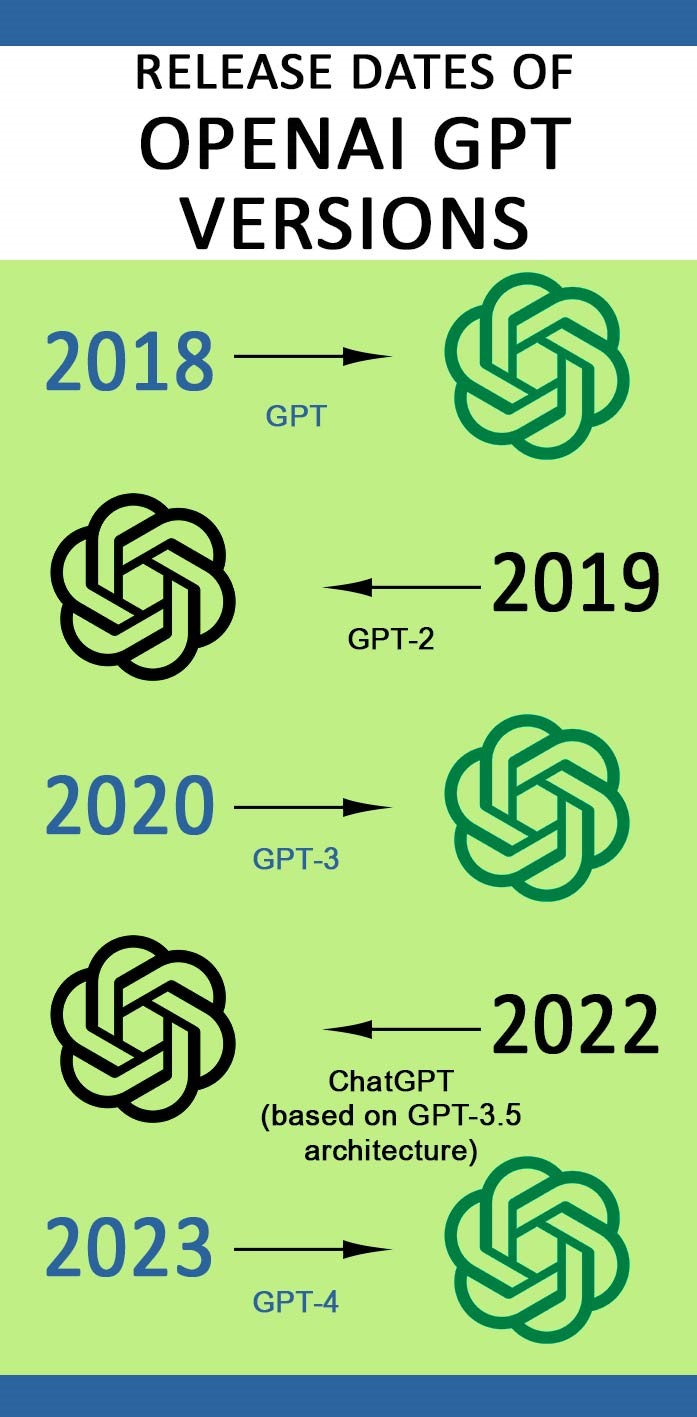I’ve analyzed all the information from the Internet that may suggest the ChatGPT 5 release date. In this article, I’ve gathered all the murmurs, unofficial disclosures, and conjecture surrounding the forthcoming significant update to ChatGPT.
In light of ChatGPT’s tremendous triumph, OpenAI perpetuates the developmental momentum for its subsequent models fueling the AI chatbot. At this moment, practically the whole technology sector anticipates OpenAI’s proclamation of GPT-5, its ensuing generation language model. Keep reading to learn as much as possible!
Table of Contents

ChatGPT is incredibly limited, but good enough at some things to create a misleading impression of greatness. it’s a mistake to be relying on it for anything important right now. it’s a preview of progress; we have lots of work to do on robustness and truthfulness. – Sam Altman, CEO OpenAI
ChatGPT 5 Release Date
I have chronologized the releases of the chat versions as well as listed features to understand how artificial intelligence has evolved over this period of time:
1. GPT (Generative Pretrained Transformer) – June 2018
- Introduction of the foundational model.
- Application of the transformer architecture to language understanding and generation.
- Displayed robust performance across various NLP tasks without task-specific training data.
2. GPT-2 – February 2019
- Introduced larger models with up to 1.5 billion parameters.
- Demonstrated enhanced capabilities in numerous NLP tasks and applications.
- Initially not released publicly due to fears of malicious use.
3. GPT-3 – June 2020
- Emerged as one of the largest language models with 175 billion machine learning parameters.
- Excelled across multiple tasks, often without the need for specialized training data.
- Opened up novel use-cases across industries, like drafting emails, answering questions, creating written content, and even aiding in computer programming.
4. ChatGPT (based on GPT-3.5 architecture) – January 2022
- Leveraged the GPT-3.5 architecture to provide enhanced conversational capabilities.
- Not a distinct generational release, but a specialized application of the GPT-3.5 model.
- Became popular for generating coherent and contextually relevant dialogues.
5. GPT-4 (with a paid subscription allowing users access to the Chat GPT-4 AI tool) – March 2023
- Enhanced the generation of text to more accurately mirror human behavioral and speed patterns, promising a substantial performance improvement compared to GPT-3.
- Exhibits increased adaptability and flexibility in executing tasks such as language translation and text summarization. Is far more creative, and it collaborates with people on creative projects much better.

Based on this data, it is clear that every 1-2 years is released an update. And we can assume that the ChatGPT 5 release date is due in 2025.
It is also known that OpenAI submitted a trademark for GPT-5 with the USPTO on July 18th, 2023. Despite this thrilling progression, the arrival of GPT-5 remains uncertain. Indeed, some specialists propose that OpenAI may introduce GPT-4.5, a mid-stage release between GPT-4 and GPT-5, by 2024, paralleling the prior introduction of GPT-3.5.
Will There ChatGPT 5?
I can confidently give you a few reasons why GPT LLM v.5 will still come out. Let’s look at them.
- Continuous Evolution and Competing Technologies: Given the persistent advancements in AI research and development, the journey of OpenAI’s technological progress hasn’t likely concluded with GPT-4. The emergence of comparable and potentially rival technologies, such as Google’s recently announced multimodal Gemini language model, underscores the imperative for OpenAI to continue innovating to retain its competitive edge in the AI landscape.
- User Accessibility and Subscription Barriers: The access barrier established by the ChatGPT Plus subscription, priced at $20 a month, which is indispensable to utilize the full spectrum of GPT-4’s capabilities, contrasts sharply with the free access previously provided by GPT-3.5. The scenario introduces an accessibility and usability challenge that might motivate OpenAI to consider alternative approaches or enhancements in future iterations, potentially including a GPT-5.
- Inclusion of Advanced Features: GPT-4 introduced several remarkable upgrades, including a broadened knowledge base and an enriched comprehension of the world, as well as new capabilities like engaging with long-form text and graph/image interpretation. These advancements, albeit substantial, hint at the potential for further enhancements and additional features in subsequent models, suggesting that a ChatGPT 5 could emerge to bring forward more refined capabilities and perhaps address existing limitations, such as the full integration of visual inputs.
How Much Will OpenAI GPT-5 Cost?
Before talking about price, I suggest you take a look at the current situation:
Free Version of ChatGPT 3.5
- Accessibility: Available to all users.
- Capabilities: Limited and constrained by resources.
- Speed and Quality: Slower responses and possibly suboptimal results compared to advanced AI in 2023.
- Purpose: Functions akin to a demo to potentially entice users towards the paid version.
Paid Version of ChatGPT 4
- Availability: Accessible through a subscription plan.
- Cost: USD 20 per month.
- Enhancements: Notable improvements over GPT 3.5 in several areas.
- Logical Reasoning: Enhanced capabilities.
- Knowledge Base: Expanded, albeit up to the year 2021.
- Visual Understanding: Can comprehend images and graphs.
- Text Processing: Able to handle up to 25,000 words simultaneously, making it useful for document cross-checking.
Given the upgrade from ChatGPT 3.5 to ChatGPT 4 involved the introduction of a USD 20 per month subscription, I can conclude that a further enhancement to ChatGPT 5 could potentially see:
- A similar or slightly higher subscription cost, if the advancements and new features significantly outweigh those of ChatGPT 4.
- The introduction of tiered pricing, offering different levels of access and features at various price points.
- Maintenance of a free access level to ensure continued accessibility for general use while providing premium features for paying subscribers.
The GPT-5 Features That We Want to See
Having studied the feedback of users on the network and taking into account their wishes, I made a list of features that GPT-5 could bring in the next version.
1. Possibility of Understanding Audio/Video (Multi-Modality Learning)
With GPT-4 introducing a visual understanding through image inputs, a leap toward understanding audio and video would be monumental. Enabling ChatGPT to interpret and generate responses based on audio and video inputs would enhance its utility across varied applications – from generating automatic captions to providing responses in context to video content.
2. Better Knowledge
- Real-time Updates: Current iterations do not have real-time knowledge updates. Enabling AI chat to learn and update its knowledge base continuously or in real-time would make it astoundingly useful for providing accurate and current information.
- Depth of Understanding: Enhancing the depth and breadth of understanding on myriad topics, ensuring it can provide richer and more insightful responses.
3. AGI (Artificial General Intelligence)
A stride towards AGI would mean GPT-5 model could understand, learn, and apply knowledge across diverse domains, mimicking human-like comprehension and problem-solving abilities. It would imply an ability to understand context, adapt to different scenarios, and make reasoned decisions with minimal human input.
4. Revolutionized Language Mastery (Large Language Model)
- Multilingual Proficiency: Refined comprehension and communication skills in multiple languages, catering to a global audience.
- Nuanced Understanding: Mastery over colloquial language, dialects, and the ability to understand and generate nuanced, emotive, and contextually rich responses.
5. Expanded Token Capacity (Long Term Memory)
Increasing token capacity would mean the model can process, recall, and utilize larger chunks of text in a single instance. Enhanced long-term memory would also enable it to remember previous interactions or information, providing a more coherent and contextually relevant user experience.
6. More Truthful
Developing mechanisms that allow ChatGPT 5 to verify the information, discern between credible and non-credible sources, and thereby generate more accurate and truthful responses would significantly enhance its reliability and usability across various sectors.
7. Reasonable Pricing of GPT-5
Ensuring that the pricing model for ChatGPT 5 is reasonable and accessible for a wide array of users while balancing the need to sustain development and support. Implementing a pricing model that offers various tiered options could make advanced AI accessible to individual users, small businesses, and large enterprises alike.
Custom Vote
Vote and you will see which features are most expected in the new version:
Is the ChatGPT 5 dangerous?
The next big update of GPT-5 is in progress, yet there has been a notable effort to hinder its advancement. An appeal, endorsed by over a thousand notable individuals and technology leaders, has been released, soliciting a temporary cessation of development beyond GPT-4. Influential participants in the appeal encompass Elon Musk, Steve Wozniak, Andrew Yang, among others.

Credit: Future of Life Institute
The focal point of the appeal unambiguously addresses GPT-5, as apprehensions regarding the technology escalate among governmental bodies and the wider public.
OpenAI has declared that there are no current plans to train a successor to GPT-4. As recent as June 2023, CEO Sam Altman reiterated the company’s stance, revealing there were no immediate plans to commence training a new model. Speaking at a conference in India, Altman expressed, “We’re working on the new ideas that we think we need for it, but we are certainly not close to it to start.”
Without explicit information or the GPT-5 release, we cannot directly address its potential risks or safety. However, the hypothetical concept of ChatGPT 5 or any other sophisticated AI model could present challenges or dangers depending largely on its capabilities and the ways it is utilized.
Ethical and Safety Considerations in AI Development:
- Misinformation: AI models can unintentionally spread or create misinformation if they generate inaccurate or misleading responses.
- Biases: If not carefully curated and monitored, AI can perpetuate or even amplify existing biases in the data it was trained on.
- Privacy: Managing and ensuring the privacy of user data and interactions is crucial.
- Manipulation: There’s the risk that such technology could be used to create convincingly realistic fake content, such as deep fakes.
- Dependency: Overreliance on AI for critical thinking or decision-making can be precarious.
- Security: Advanced AI models can potentially be targeted for cyber-attacks, and ensuring their security is pivotal.
- Job Displacement: Automated systems can sometimes replace human roles in certain sectors, raising concerns about job displacement.
- Ethical Use: Ensuring that AI is used ethically and responsibly, avoiding malicious use such as generating harmful or inappropriate content.
- Regulation Compliance: Adhering to local and global regulations regarding technology, data protection, and user safety.
Addressing the Challenges:
OpenAI, as seen with previous models, follows a robust approach to mitigate risks associated with AI:
- Safety Protocols: Developing and implementing protocols to ensure that the AI behaves predictably and safely.
- Regular Updates: Ensuring the model evolves and adapts to minimize unintended consequences, such as generating inappropriate or unsafe content.
- User Feedback: Actively seeking and incorporating user feedback to continually improve and safeguard the AI’s performance.
- Accessibility and Fair Use: Implementing guidelines and monitoring systems to ensure the AI is used fairly, ethically, and is accessible.
- Privacy Protection: Employing stringent data protection and privacy policies to safeguard user interactions and information.
While AI technologies harbor incredible potential for positive impact, it is vital to approach their development, deployment, and use with a conscientious and robust framework ensuring ethical use, user safety, and data protection.
OpenAI has historically demonstrated a commitment to ensuring the ethical development and deployment of AI, aligning technology evolution with ethical and safety considerations. Future versions, such as a hypothetical ChatGPT 5, would likely be developed with these same considerations at the forefront.
FAQ
When was GPT-4 released?
When was GPT-3 released?
What is ChatGPT Plus?
Last Words
The mystery encircling the ChatGPT 5 release date continues to burgeon, intertwining expectations and anxieties about the technological and ethical leaps it might embody. Throughout the progression from GPT to ChatGPT 4, we’ve witnessed remarkable strides in artificial intelligence.
While the advancements and anticipated capabilities of ChatGPT 5 undoubtedly stir excitement, the imperative to maneuver through its development and launch with a profound emphasis on ethical use, safety, and potential risk mitigation stands paramount. As we stand on the cusp of this potential new era, ensuring that the collaboration between developers, users, and regulators is robust will be pivotal in steering the AI not just toward operational excellence, but ethical and societal alignment.
As always, stay tuned for updates and official announcements about the ChatGPT 5 on the official OpenAI website.





